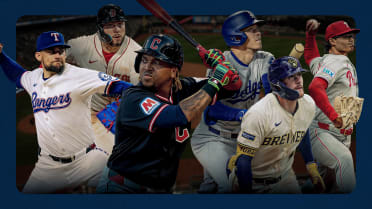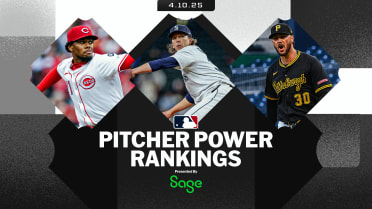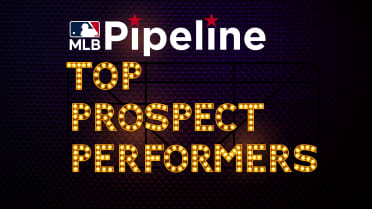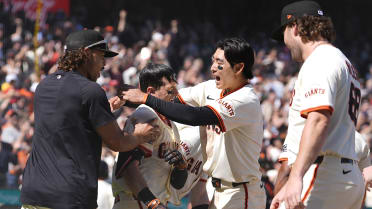With some players, stardom is obvious right from the beginning. The production is undeniable, and a consensus quickly forms: This guy is the real deal.
But often, it's not so clear. Neither scouts nor statistical projections are correct anywhere close to 100% of the time, and players surprise. They surpass expectations. They evolve. And the opinions of teams, evaluators, fans and media members evolve with them.
In that spirit, MLB.com gathered 11 writers and asked them this question: "Which player has changed your mind?" These are the guys who have turned us from doubters into believers.
Player: Tim Anderson, SS, White Sox
Writer: Anthony Castrovince
Sitting in a dugout late in 2016, shooting the breeze about various players around the league, an executive you have heard of and respect (and who shall remain nameless here) didn’t have much good to say about Anderson’s offensive potential:
“Tim Anderson doesn’t know the strike zone from [um, somewhere else],” the exec said.
The above was not an uncommon sentiment early in Anderson’s career. In his first three seasons, he had an uninspiring .258/.286/.411 slash with 428 strikeouts and only 56 walks. So for Anderson to win one batting title (in 2019) and vie for another (in 2020) is sort of stunning. He still doesn’t draw walks, and he has an abnormally high batting average on balls in play over those two seasons (.395, the highest in MLB by 14 points in that span). But his legs and batted-ball profile make that BABIP sustainable, his pitch recognition has improved and his quality of contact has grown substantially (his 10.1% barrel rate last year was almost double what it was in 2019). Combine all that with the swag he brings to a ballclub, and Tim Anderson can play for my team (and I bet the executive referenced above would say the same now).
Player: Javier Báez, SS, Cubs
Writer: David Adler
At first I thought Báez was too much peaks and valleys to be a really great player. For every Ruthian hack that connected for a home run, he'd wave at a slider a foot off the plate and strike out. He'd make highlight-reel plays in the field, but other times it looked like his flair for the flashy was costing him an easier way to get the out. Nothing wrong with making baseball look cool, though. And when I kept watching him more and more, he just straight-up won me over.
Báez's 2018 season -- a .290 average and .554 slugging, 34 home runs, 21 steals and an MVP runner-up finish -- proved he could hack-and-flash his way to a complete, elite season. And his followup in 2019 -- when he moved to shortstop and was immediately the best fielder in all of baseball (+28 Outs Above Average) and turned into an opposite-field hitting machine (he finished with 14 oppo homers, second-most in MLB) -- showed he could evolve as a player and stay an all-around superstar. Baez crushed 29 more homers and swiped 11 more bags in '19 while hitting .281 and slugging .531, even after suffering through a fractured thumb down the stretch. Throw out his slump in the weird, short 2020 season. El Mago is not a vanishing act. Javy is just one of the most exciting players in the game.
Player: Trevor Bauer, SP, Dodgers
Writer: Jesse Sanchez
I remember when the D-backs drafted Bauer back in 2011. I actually drove from my home in Phoenix to Tucson to watch one of his early Minor League starts. It was easy to see why he was a star in college and selected in the first round of the Draft, because his pure stuff was amazing. Sure, he had success in the Minors, but he didn’t repeat it at the big league level in Arizona, and they eventually traded him to the Indians in 2012. Seven years later, he was traded to the Reds. There are multiple reasons why he was with three teams before signing with the Dodgers, but the one constant was his pitching ability and work ethic. Back in those days, he was considered a solid big league pitcher, but generally speaking, he was never a star and not an ace. I had my doubts. We all did, especially when you remember the expectations placed upon him and saw the results.
That’s not the case anymore. So, yes, I’m buying the reigning NL Cy Young Award winner as a pitcher in 2021. I know, I know, but it’s more complicated than it sounds. Hear me out. The numbers speak for themselves but I also think there is something to be said about maturing as a player with age (he’s 30), and I’ve watched him evolve on the field in the last 10 years. He’s polarizing for sure and probably always will be, but he also has an electric arm and he knows what he is doing on the mound.
Player: Clint Frazier, OF, Yankees
Writer: Mark Feinsand
When Frazier came to the Bronx in the Andrew Miller trade during the summer of 2016, it seemed like the Yankees had landed themselves a star. Every scout I spoke to raved about his quick hands, masterful approach at the plate and absolute fearlessness.
His first taste of the big leagues the following year was very anticlimactic as he slashed .231/.268/.448 in 39 games. Worse than his production, however, was his attitude. Several veterans and people around the club told me he was very immature, an entitled kid who acted like a guy with 10 years of service time. Frazier appeared in just 15 games in 2018, then after getting another shot in 2019, it finally appeared that his bat was ready for big-league pitching. The attitude, on the other hand, was still in question.
Following an early-June game against the Red Sox in which he made an untimely error, Frazier ducked the media after the game, leaving his teammates to answer for him. That didn’t go over well inside the clubhouse or upstairs in the front office; less than two weeks later, Frazier was optioned back to Triple-A, where he remained until he was called up again on Sept. 1. The idea of Frazier ever “getting it” and becoming a big star seemed to be waning by the day.
Yet last year, Frazier played 39 games during the 60-game 2020 campaign, slashing .267/.394/.511 with eight homers in 131 at-bats. More importantly, Frazier seems to have grown up in the past year or two, apparently learning from his first few years in New York. He’s proven the ability to produce at the plate, has become a better defensive outfielder and has figured out what it takes to be a good teammate. Still only 26 years old, Frazier might wind up fulfilling his potential after all.
Player: Lucas Giolito, SP, White Sox
Writer: Mike Petriello
I was so out on Giolito that I was out on him before he even landed in Chicago. The ink wasn’t dry on the paperwork that finalized his trade to the White Sox (do trades actually come through on paper? I have no idea) when I tweeted that in his brief Washington cameo in 2016, he’d had the 12th-worst strikeout rate of more than 500 pitchers who’d thrown at least 20 innings. Small sample from a rookie? Sure. Is that bad? You better believe it. The names surrounding him were Tyrell Jenkins, Eric Surkamp, Justin Nicolino and Keith Hessler. You don’t know who they are. That’s kind of the point.
In my defense, he then spent the next two seasons being entirely terrible. Giolito wasn’t that impressive in Triple-A in 2017, and struck out only 34 in 45 1/3 Major League innings. The next year, he was basically the worst regular starter in baseball. The velocity, spin and movement on his fastball were all unimpressive. He looked like he didn’t have the stuff to succeed in the Majors, simple as that.
But in 2019, it all changed. Giolito tossed 176 2/3 innings of 3.41 ERA baseball, literally doubling his strikeout rate from 16% to 32%. He was even better in 2020, throwing a no-hitter. He’s received Cy Young votes in each of the last two years. It’s not a fluke, and it’s not a mystery; in the 2018-19 offseason, Giolito completely remade himself, from physical training to mental preparation to different mechanics. If it looks like he’s a completely different pitcher, well, that’s because he is. I don’t even really consider my earlier evaluation a miss for that reason; that guy couldn’t pitch in the bigs. This guy can dominate. The ways he’s done it have more than convinced me that he’ll be able to keep doing it for years to come.
Player: DJ LeMahieu, INF, Yankees
Writer: Andrew Simon
It’s not as if I looked at LeMahieu’s time with the Rockies (2012-18) and thought, “There’s no way he can maintain this away from Coors Field.” That phenomenon is a big baseball myth. By far the bigger issue is that LeMahieu just wasn’t that great in Colorado, only producing league-average offensive numbers (by park-adjusted metrics) in his batting-title-winning season of 2016. Over the next two years, his 91 wRC+ was tied for 98th of 122 qualifiers. There were things to like about LeMahieu’s profile -- few strikeouts, lots of hard contact -- but nothing that suggested to me he’d be more than a solid complementary piece in a powerful Yankees lineup when the club signed him in January 2019.
Well, about that. LeMahieu has been the Yanks’ best player over the past two seasons, and he’s done it without dramatically changing that profile. Ironically, LeMahieu has hit far better at Yankee Stadium than he even did at Coors Field, and watching him shoot line drive after line drive the other way has become a delightful ritual. Just like the Yankees, who committed $64 million more to LeMahieu this offseason than they did two years before, I’ve reevaluated.
Player: Kenta Maeda, RHP, Twins
Writer: Thomas Harrigan
Maeda started 71 games for the Dodgers in the regular season from 2017-19. The Dodgers made the playoffs in all three years. You know how many postseason starts Maeda made in that span? Zero. Part of that had to do with the Dodgers’ rotation depth, as well as their shaky bullpen. But still. For three straight years, Los Angeles decided that Maeda was more valuable as a middle reliever, throwing one or two innings max, in its most important games of the season. Then, the Dodgers opted to trade him to the Twins in a four-player deal that brought back hard-throwing prospect Brusdar Graterol in February 2020.
It wasn’t seen as a slam-dunk trade for the Twins. But Maeda went on to record a 2.70 ERA with a Major League-leading 0.75 WHIP, 80 strikeouts and 10 walks over 66 2/3 innings, and he tossed five scoreless innings against the Astros in the American League Wild Card Series -- his first postseason start in four years. He finished second in the AL Cy Young race behind Cleveland’s Shane Bieber.
Maeda’s performance appears to be sustainable. He has always been dominant against right-handed batters, but he was held back by his lack of effectiveness against lefties. That changed last season, when he threw his slider nearly three times as often against left-handed batters and held them to a .525 OPS. Maeda also decreased his four-seam fastball usage in all matchups and had more success with the pitch than ever before. Maeda misses bats at an elite level, and he limits hard contact and walks. He’s turned into a true ace, which seemed unlikely as recently as one year ago.
Player: Trevor Story, SS, Rockies
Writer: Sarah Langs
We all remember Story’s eye-opening 2016 debut, when he hit two homers on Opening Day and proceeded to homer in each of his first four games. At the time, it seemed like he’d primarily be known for power. There’s nothing wrong with that, but Story has shown himself to be adept across the board, with speed, defense and hitting ability. To be completely fair, the speed was always there -- he was 98th percentile in Sprint Speed in ’16 -- and the defense wasn’t bad at all, as he had four Outs Above Average before his July injury that year. But, after a -5 OAA showing in 2018, he rebounded with 18 OAA in 2019, solidifying himself as a well-regarded defender.
The other thing that's changed? Story's strikeout rate, which has dropped from over 31% in 2016 and '17 to below 27% in each year since, including 24.3% in 2020. There’s still room for improvement there, but Story has showed he can't just be classified as a "strikeout and home run guy."
All of this is to say, I’m not sure Story was fully on the collective radar as a stellar part of this upcoming free-agent shortstop class a few years ago, but with what he’s done since 2019 began, especially, he’s shown he’s a strong all-around player.
Player: Eugenio Suárez, SS/3B, Reds
Writer: Manny Randhawa
For me, 2018 was an eye-opener when it came to Suárez, a relatively small guy (listed at 5'11") who had to that point shown some pop, but mostly in hitter-friendly Great American Ball Park, where 21 of his career-high 26 homers in ’17 came. It was in ’18 that he not only elevated his production at the plate dramatically, but also evened out those home-road splits somewhat -- 15 of his 34 homers came on the road. And then in ’19 he was even better, smashing 49 homers, 24 coming in Cincinnati and 25 coming on the road.
Though Suárez took a step back last year, that can be said of a number of sluggers who went cold at the plate in the pandemic-shortened 2020 campaign. He still strikes out too much (an MLB-leading 189 punchouts in ’19), but for a guy who had 38 homers to his name through his first three MLB seasons to become a masher with a legit chance to join the 50-homer club at some point is a remarkable evolution.
Player: Kyle Tucker, OF, Astros
Writer: Alyson Footer
The hype around Kyle Tucker when he attended his first big league camp was typical for a former first-round Draft pick, but my eyes would glaze over every time I’d hear someone refer to him by the nickname “Ted,” as in, his swing looks just like that of Hall of Famer Ted Williams. Things can only go down from there, right? And, well, at the beginning, they sort of did. Tucker blistered baseballs in Grapefruit League play in 2018, but in limited time in the big leagues over two seasons, his numbers were not good. Add to that former manager AJ Hinch being wholly unimpressed with Tucker’s lack of a pregame regimen, and there were questions whether Tucker would ever meet those sky-high expectations.
Fast forward to 2020, long after the Ted talk died down and Tucker was receiving his first real chance to start every day in the outfield. Though inconsistent for stretches, he turned in a solid season, posting a 123 OPS+ while slugging nine homers over 58 games. He also was nominated for a Gold Glove Award. Spring Training of 2021 marked the first time in his career that he did not have to actually make the team. He is a fixture in the outfield, will play every day, and I’m beginning to think he should be my pick for team MVP.
Player: Mike Yastrzemski, OF, Giants
Writer: Jason Catania
Despite being the grandson of Hall of Famer Carl Yastrzemski and a product of one of college baseball’s best programs in Vanderbilt, Mike didn’t reach The Show until late May 2019 … at nearly 29 years old. Having been drafted three times -- never higher than in the 14th round -- Yastrzemski toiled in Baltimore’s Minor League system for parts of (count ’em) seven seasons before an unnoticed trade to the Giants in late March 2019 offered opportunity.
So forgive folks for thinking maybe the younger (though no longer young) and undersized Yaz (5-foot-10, 178 pounds) was unlikely to amount to much in the Majors, let alone reach them. Alas! The outfielder burst onto the scene in ’19, hitting .272/.334/.518 (122 OPS+) with 21 homers in 107 games. While it made for an amazing story with some memorable moments, Yastrzemski came from so far out of nowhere that it was easy to dismiss him. Turns out, Yaz genuinely improved with a change of scenery, following up with an even better performance in the shortened 2020 season. He ascended to the top of the Giants’ lineup and batted .297/.400/.568 (165 OPS+) -- good enough to finish eighth in NL MVP voting. Yastrzemski did that by altering his swing (his 18.4-degree average launch angle ranked in the top 20 last year), focusing on making harder contact and enhancing his plate discipline (his walk rate climbed from 7.8 percent to 13.3 percent).
Now, maybe Yastrzemski won’t wind up being a perennial MVP candidate like his grandpops, but his path and performance show what the right mechanical adjustments, a change in approach and, oh yeah, opportunity -- even at a later age -- can do for a player.



